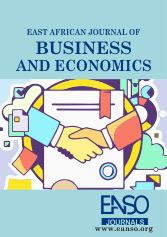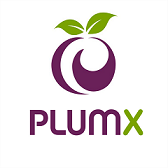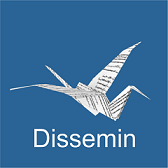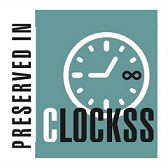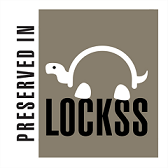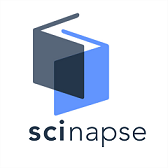The Role of Small and Medium Enterprises in Public Procurement: Barriers, Strategies, and Socio-Economic Impacts in Uganda
Abstract
Public procurement makes up a significant share of Uganda’s economy, yet small and medium-sized enterprises (SMEs) account for only 15% of government contracts despite contributing 18% to GDP and 90% of private sector employment. This study examined the barriers, strategies, and socio-economic contributions associated with SME participation in public procurement for services and supplies. Using a qualitative action research design, data were collected from 17 purposively sampled SMEs in Kampala and Gulu through semi-structured interviews. Thematic analysis, guided by Institutional Theory, Resource-Based View, Knowledge-Based View, Stakeholder Theory, and Innovation Theory, revealed three major barriers: i) regulatory constraints (complex bidding procedures, strict prequalification, and lengthy processes), ii) structural resource limitations (financial capital, skilled labour, and IT infrastructure), and iii) skills gaps coupled with information asymmetries. SMEs employ diverse strategies to enhance competitiveness, including advocating for policy reforms, improving access to finance and technology, fostering collaborations, and building digital and entrepreneurial capacities. Findings highlight that participation of SME generates substantial socio-economic benefits, including revenue growth, job creation, innovation, community development, and enhanced procurement transparency. Differences in access to technology and finance emerged between urban Kampala and regional Gulu SMEs. The study concludes that targeted policy interventions, resource support, and tailored capacity-building programs are essential to enhance SME inclusivity in Uganda’s procurement ecosystem. These findings provide actionable insights for policymakers, procurement authorities, and development partners seeking to promote inclusive growth through procurement reforms
Downloads
References
Ahmed, S. K. (2024). How to choose a sampling technique and determine sample size for research: A simplified guide for researchers. Oral Oncology Reports, 12, 100662.
Aigheyisi, O. S., & Edore, O. J. (2015). Public procurement, governance and economic growth: some policy recommendations for Africa’s growth and development. International Journal of development and management Review, 10(1), 110-124. Akenroye, T. O., Owens, J. D., Elbaz, J., & Durowoju, O. A. (2020a). Dynamic capabilities for SME participation in public procurement. Business Process Management Journal, 26(4), 857-888.
Akenroye, T. O., Oyegoke, A. S., & Eyo, A. B. (2020b). Development of a framework for SMEs' participation in public procurement in developing countries. Journal of Purchasing and Supply Management, 26(2), 100558.
Allen, B. (2021). Does strategic public procurement for SMEs work? Evidence Base, 2021(2), 39–64. https://doi.org/10.21307/eb-2021-003
Ancarani, A., Di Mauro, C., & Mascali, F. (2019). Public procurement of innovation: A review of barriers and enablers. Public Management Review, 21(1), 1–27.
Aziz, A., & Khan, N. (2020). The potential uses of pilot study in qualitative research. Journal of Research & Reviews in Social Sciences Pakistan, 3(1), 750-767.
Barney, J. (1991). Firm resources and sustained competitive advantage. Journal of Management, 17(1), 99–120.
Braun, V., & Clarke, V. (2021). Can I use TA? Should I use TA? Should I not use TA? Comparing reflexive thematic analysis and other pattern‐based qualitative analytic approaches. Counselling and psychotherapy research, 21(1), 37-47.
Bryman, A. (2016). Social research methods (5th ed.). Oxford University Press.
Calderón, C., Chong, A., & Chong, M. (2018). The effects of procurement procedures on SMEs in Latin America. Inter-American Development Bank Working Paper.
Coghlan, D. (2023). Action research as the social science of change and changing. In Handbook of Research Methods in Organizational Change (pp. 19-46). Edward Elgar Publishing
Cohen, L., Manion, L., & Morrison, K. (2018). Research methods in education (8th ed.). Routledge.
Creswell, J. W., & Poth, C. N. (2018). Qualitative inquiry and research design: Choosing among five approaches (4th ed.). SAGE Publications.
Demarco. C. (2020) Defining the Conceptual Framework. Retrieved from https://resources.nu.edu/c.php?g=1013602&p=7661246
Di Mauro, C., Ancarani, A., & Hartley, T. (2020). Barriers to SME participation in public procurement: A comparative study. Journal of Public Procurement, 20(1), 55–72.
European Commission (2021) SME Needs Analysis in Public Procurement - Final report. Retrieved from https://ec.europa.eu/
Etuk, R. U., Etuk, G. R., & Baghebo, M. (2014). Small and medium scale enterprises (SMEs) and Nigeria’s economic development. Mediterranean Journal of Social Sciences, 5(7), 656–662.
Fayos, T., Calderón, H., García-García, J. M., & Derqui, B. (2022). The upcoming rise of SMEs in cross-border public procurement: is it a matter of networking capabilities? Journal of International Entrepreneurship, 20(4), 537-563.
Ferraz, C., Finan, F., & Szerman, D. (2015). Procuring firm growth: the effects of government purchases on firm dynamics (No. w21219). National bureau of economic research.
Flynn, A., McKevitt, D., & Davis, P. (2015). The impact of size on small and medium-sized enterprise public sector tendering. International Small Business Journal, 33(4), 443-461.
Flynn, A. (2016). Investigating the influence of capabilities on SME activity and participation in public procurement. Environment and Planning C: Government and Policy, 34(5), 885–909.
Flynn, A., & Davis, P. (2016). Firms’ experience of SME-friendly policy and their participation and success in public procurement. Journal of Small Business and Enterprise Development, 23(3), 616-635.
Flynn, A., & Davis, P. (2016). The policy–practice divide and SME-friendly public procurement. Environment and Planning C: Government and Policy, 34(3), 559-578.
Flynn, A., & Davis, P. (2017). Explaining SME participation and success in public procurement using a capability-based model. Public Administration, 95(3), 723–738.
Freeman, R. E. (1984). Corporate views of the public interest. https://doi.org/10.5465/amr.1984.4277733.
Gladkova, V. E., Yakhyaev, M. A., Korolkov, V. E., Smirnova, I. A., Litvinenko, I. L., & Pinkovetskaya, J. S. (2018). The access of Russian small enterprises to public procurement markets: data analysis. Amazonia Investiga, 7(15), 20-31.
Govender, N.M. and Pretorius, M. (2015). A critical analysis of information and communications technology adoption: The strategy-as-practice perspective, Acta commercii 15(1), Art.#229, pages 1-13. http://dx.doi.org/10.4102/ac.v15i.229
Grant, R. M. (1996). Toward a knowledge-based theory of the firm. Strategic Management Journal, 17(S2), 109–122.
Hennink, M. M., & Kaiser, B. N. (2022). Qualitative research methods (2nd ed.). SAGE Publications.
Hoekman, B., & Tas, B. K. O. (2020). SME participation in public purchasing: procurement policy matters. Robert Schuman Centre for Advanced Studies Research Paper No. RSCAS, 38.
Hoekman, B., & Taş, B. K. O. (2022). Procurement policy and SME participation in public procurement: Cross-country evidence. Small Business Economics, 55, 107–121.
Israel, B., & Kazungu, I. (2019). The role of public procurement in enhancing growth of small and medium sized enterprises: experience from Mbeya Tanzania.
LaBelle, J. (2022). Unlocking procurement opportunities for SMEs. OECD Working Paper.
Landau, P. (2021). Identifying and Overcoming Resource Constraints in Project Management. Retrieve from https://www.projectmanager.com/.
Loader, K., & Norton, S. (2015). SME engagement in UK public procurement: Enablers and barriers. Public Money & Management, 35(3), 225–232.
Loader, K. (2016). Is local authority procurement supporting SMEs? An analysis of practice in English local authorities. Local Government Studies, 42(3), 464-484.
Mahuwi, L., & Israel, B. (2023). A review on participation of SMEs in public procurement: opportunities, challenges, and policy implications. New Applied Studies in Management, Economics & Accounting, 6(4), 18-33.
Maxwell, J. A. (2022). Interactive Approaches to Qualitative Research Design. The SAGE Handbook of Qualitative Research Design, 41.
Miles, M.B., Huberman, A.M. & Saldana, J. (2019). Qualitative Data Analysis: A Methods Source Book (4th ed.). Thousand Oaks, CA: Sage.
MOFPED (2021) Uganda Economic Performance Prior to 2021 General Election. Retrieved from https://umra.go.ug/.
Nathan (2015) National Small Business Survey of Uganda. Retrieved from https://www.nathaninc.com.
OECD (2017) Enhancing the Contributions of SMEs in a Global and Digitalized Economy. OECD Publishing, Paris.
OECD (2018). SMEs in Public Procurement: Practices and Strategies for Shared Benefits, OECD Public Governance Reviews, OECD Publishing, Paris. https://doi.org/10.1787/9789264307476-en
OECD (2018). Public procurement for innovation: Good practices and strategies.
OECD (2022), Financing SMEs and Entrepreneurs 2022: An OECD Scoreboard, OECD Publishing, Paris, https://doi.org/10.1787/e9073a0f-en.
Osanloo, A. F., & Grant, C. (2016). Understanding, selecting, and integrating a theoretical framework in dissertation research: Creating the blueprint for your “house”.
PPDA (2016) The 3rd Public Procurement Integrity Survey. Retrieved from https://www.ppda.go.ug/.
PPDA (2020). The 4th Procurement Integrity Survey. Retrieved from https://www.ppda.go.ug/
PPDA (2024) Finance Minister Issues New PPDA Regulations 2023. Retrieved from https://www.ppda.go.ug/.
Reijonen, H., Tammi, T., & Saastamoinen, J. (2016). SMEs and public procurement: Does entrepreneurial orientation matter? Journal of Public Procurement, 16(3), 312–336.
Saastamoinen, J., Reijonen, H., & Tammi, T. (2017). The role of training in dismantling barriers to sme participation in public procurement. Journal of Public Procurement, 17(1), 1-30.
Saunders, M., Lewis, P., & Thornhill, A. (2016). Research methods for business students (7th ed.). Pearson Education Limited.
Saunders, M., Lewis, P., & Thornhill, A. (2016). Research methods for business students (7th ed.). Pearson Education Limited.
Schumpeter, J.A. (1934). The Theory of Economic Development, Cambridge, ma: Harvard University Press.
Scott, W. R. (2014). Institutions and Organization. Ideas, Interests, and Identities. Fourth Edition. Los Angelos.
Sönnichsen, S. D., & Clement, J. (2020). Review of green and sustainable public procurement: Towards circular public procurement. Journal of Cleaner Production, 245, 118901.
Testa, F., Annunziata, E., Iraldo, F., & Frey, M. (2016). Drawbacks and opportunities of green public procurement: An effective tool for sustainable production. Journal of Cleaner Production, 112, 1893–1900.
Thyer, B. A. (2020). The handbook of social work research methods (3rd ed.). SAGE Publications.
Transparency International. (2019). Corruption Risks in Public Procurement. TI Global Reports. Retrieved from https://knowledgehub.transparency.org/.
Uganda Investment Authority (2015) Uganda Micro, Small and Medium Enterprise Policy. Retrieved from https://www.ugandainvest.go.ug/.
World Bank. (2018). Enhancing SME participation in public procurement: Lessons from international practice. The World Bank. Retrieve from https://documents1.worldbank.org/.
WTO (2016) World Trade Report 2016 Levelling the trading field for SMEs. Retrieved from https://www.wto.org/.
Zafar, A., & Mustafa, S. (2017). SMEs and innovation: Review of literature. International Journal of Engineering and Information Systems, 1(9), 106–117.
Copyright (c) 2025 Ermos Michael Jama, PhD, Pascal Muloosi

This work is licensed under a Creative Commons Attribution 4.0 International License.

